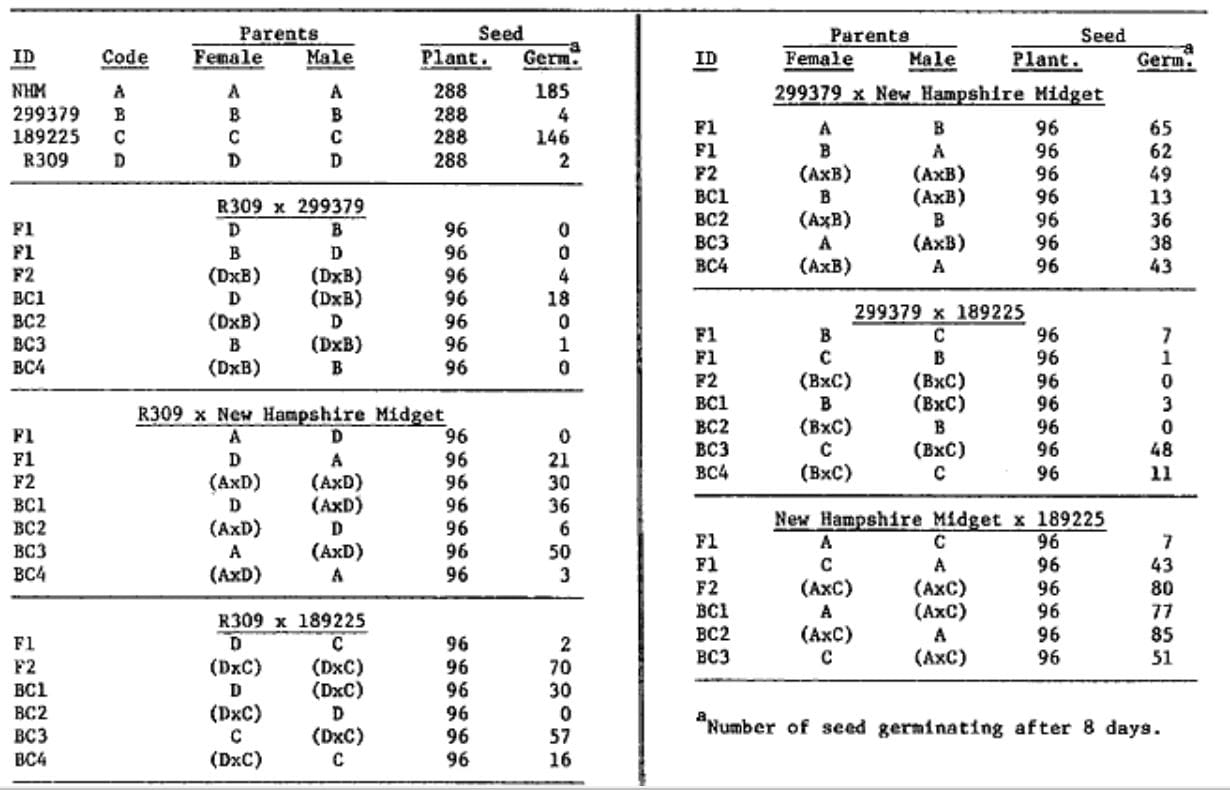Cucurbit Genetics Cooperative Report 6:64-65 (article 32) 1983
B. B. Rhodes and Stephen L. Love
Clemson University, Edisto Experiment Station, Blackville, SC 29817
Citrullus lanatus PI 299379 and PI 189225 and Citrullus colocynthis ‘R309’ show delayed germination. Since these three genotypes have shown resistance to race 2 anthracnose, we have been particularly interested in germination because poor germination hinders genetic studies.
Shimotsuma (2) studied the hybrid C. lanatus x C. colocynthis and observed that only about 50% of the F1 pollen contained a full complement of chromosomes. Cytogenetic abnormalities in the interspecific hybrid could lead to reduced germination. Lockerman and Putnam (1) reported the presence of inhibitors in the seed coat of cucumber seed. Sowell (personal communication) noted that leaching increases germination in certain Citrullus PI’s.
Germination data from families of C. lanatus and C. colocynthis ‘R309’ are given in Table 1. Note that less than 1% of the ‘R309’ seed and 1.4% of the 299379 seed germinated in an 8 day period, Reciprocal crosses between 299379 and ‘R309’ and subsequent progeny showed delayed germination. However, seed from ‘R309’ x (‘R309’ x 299379) backcross showed faster germination than either parent.

Table 1. Germination of Seed from Citrullus Lanatus (“New Hampshire Midget”, PI 299379, PI 189225) and Citrullus cococynthis ‘R309’ and F1, F2 and Backcross Progeny.
Distinct differences between ‘R309’ and 299379 are evident when these genotypes are crossed with ‘New Hampshire Midget’ (NHM). Neither ‘R309’ nor 299379 showed a reciprocal difference in the F1 generation. However, germination was nil for ‘R309’ as a pollen parent in the F1 whereas germination was relatively good for 299379. In fact, in all families surveyed, almost no germination resulted from using ‘R309’ as the pollen parent. Additional investigation is necessary to determine whether delayed germination or inviable embryos predominate in this instance.
Recessiveness is indicated in the delayed germination of 299379 since the F1 progeny from crosses with NHM germinated normally and the slowest rate of germination was recorded for the backcross 299379 x (NHM x 299379) and its reciprocal. In the cross with 189225, dominance is indicated by the low numbers of germinating seed in the F1, F2 and progeny from the backcrosses with 299379. Backcrosses with 189225 resulted in substantial germination.
Considerable variability in rate of germination and in actual germination given an unlimited time frame appears to exist in these genotypes. More work will be required to ascertain the genetic basis for these atypical germinating types.
Literature Cited
- Lockerman, R. H. and A. R. Putnam. 1981. Growth inhibitors in cucumber plants and seeds. J. Amer. Soc. Hort. Sci. 106(4):418–422.
- Shimotsuma, M. 1960. Cytogenetical studies in the genus Citrullus. IV. Intra and interspecific hybrids between C. colocynthis Schrad. and C. vulgaris. Jap. J. Genet. 34(10):303–312.